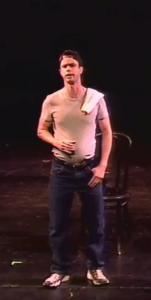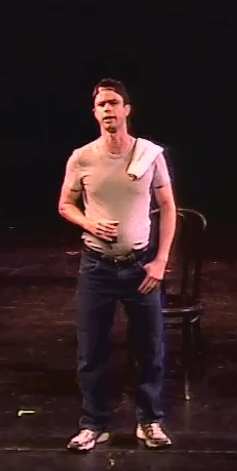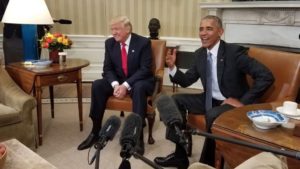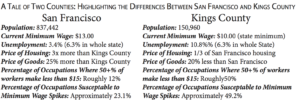
In 2008, LWHS Alumni Dan Hoyle embarked on a road-trip across the country through the reddest of red states and the smallest of small towns, the areas of the U.S. that Sarah Palin famously called “the real America” during the election that year. Trying to understand the lives of those outside of San Francisco’s liberal bubble, Hoyle spoke to a myriad of people while recording his conversations as he went. Years of work later, Hoyle had transformed his conversations into a one-man show in which he portrays the people he interviewed in an attempt to convey their thoughts and experiences to his audience. Based in the Marsh Theatre in San Francisco, though toured nation-wide, Hoyle’s show is The Real Americans.
Hoyle presented excerpts of his one-man show to Lick students in a Community Meeting on September 30, 2016. The show opened with Hoyle playing both himself and each of his four friends eating brunch in San Francisco; Hoyle jokes about the nuances of life in a liberal city. Observing his friends, including one who was always glued to his phone and another who spoke about how cliché it was to go to brunch, Hoyle displays why he wanted to break out of his liberal bubble and travel across the country. He then goes on to portray several people he interviewed during his trip, ranging from a Dominican-American veteran to a closeted gay man in a traditional Southern family. Hoyle portrays people from different geographical areas, socioeconomic statuses, and racial identities. Each character tells their own story, sharing their experiences and what factors shaped their worldview and political leanings.
Hoyle added Trump supporters to an updated version of his show in response to the election, making his performance particularly relevant in developing empathy for the different reasons people had for supporting the Presidential Elect. In an interview with the Paper Tiger, Coco Sachs ‘17 expressed how Hoyle’s performance reminded her of the drastically differing views in the country. She said how “growing up in the Bay Area and going to a place like Lick, it’s really easy to forget about places in the Deep South, or even just in almost every state… where they’re still very traditional… I think it’s very easy to overlook that.” Hoyle’s portrayal of characters who had views ranging from creationism to homophobia served as a reminder of the beliefs enduring in our nation, beliefs that were visible throughout this year’s presidential campaign.
Although there were many members of the Lick community that applauded Hoyle’s ability to humanize people with different beliefs and backgrounds, there were also people who felt uncomfortable with the characters of color in the show. While Hoyle was successful in his humanization of different political views, his portrayal of people of color as a white man requires careful consideration due to its role in a greater, highly contested narrative. (See sidebar.)
Hoyle acknowledged and responded to these concerns during the Q&A and in a follow-up interview. In his responses, he emphasized that his characters are not based on stereotypes but on individuals that he met and strived to understand. Many of his lines, including the slang used, are taken verbatim from the people he connected with. His accents and motions too, are taken from the observation of individuals that he formed personal connections with, not from stereotypes. Moreover, Hoyle stresses that he has dedicated thousands of hours of work towards obtaining accurate and authentic characters based on the people he interviewed. Hoyle is able to achieve this through the “close observation of people and their environments, what William Finnegan calls ‘the journalism of hanging out.’”
Hoyle also acknowledged the historical controversy around “whitewashing” in the media, where white actors portray roles meant for people of color. Hoyle, however, believes that he is honoring others’ stories rather than appropriating them because of the empathy and compassion that drives his work; “what I do, where I travel alone, putting myself out there in vulnerable situations with curiosity and compassion for the cultures and people I’m hanging out with… to me that’s honoring the stories of others.” Unlike in the media where actors may portray characters they have never met, and may consequently base their representations in part on stereotypes, Hoyle tries to connect both with his characters and the people he they are based on. He believes that he expressed their stories with authenticity and compassion, honoring the people he portrayed.
As a whole, Hoyle accomplished his goal of humanizing different political views and geographical backgrounds, and thoroughly attempts to present the stories of others with authenticity and compassion. People who attend The Real Americans should recognize the positive messages of Hoyle’s show, while maintaining an awareness of historical precedents of white actors playing people of color and their consequences. In a city often described as a “liberal bubble,” it is easy to make assumptions about people with different backgrounds or beliefs. Hoyle pushes those in the bubble to question “who would I be if I were brought up in that landscape and context?”
Sidebar “A Short History of White Actors Playing Characters of Other Races”:
The history of white people playing people of color dates back many centuries, but came to prominence in the early 1800s in the form of blackface. Thomas D. Rice, who performed under the stage name “Daddy Jim Crow,” introduced his song “Jump Jim Crow” in 1828 with his face painted black, singing and dancing while depicting an African American man in his song. Deprecating African Americans as unintelligent and aggressive towards women, his song instantly became a hit, and launched a long-standing tradition of white performers perpetuating degrading African American stereotypes.
The tangible repercussions of performances like “Jump Jim Crow” were tremendous. Jim Crow, the stereotype-based African American in Rice’s song, became a demeaning symbol for blacks. Jim Crow laws, which segregated and discriminated African Americans from the mid 1800s to 1900s, actually took their name from the African American in Rice’s song.
Blackface and yellowface (white actors painting their faces to appear Asian and appropriating and mocking Asian cultures) continued to encourage racial stereotypes and promote racial violence throughout the 1900s. For example, in D.W. Griffith’s “The Birth of a Nation,” a film released in 1915, blackface actors adopted Thomas Rice’s caricature of African Americans as stupid, barbaric, and inferior to whites, just as minstrel troupes had done for nearly a century. Encouraged by the negative portrayals of blacks in the movie, a mob of white people killed an African American teenager after viewing the film. The Klu Klux Klan even used “The Birth of a Nation” to start a recruitment campaign, due to its promotion of racial animosity.
The encouragement of racial stereotypes and discrimination is only a part of the historical injustice of whites playing people of color. The appropriation of African American culture that profited off of these harmful, demeaning messages, while eliminating the weight of African American voices, is comparably unjust. As white minstrel troupes traveled across the country in the 19th century while performing using blackface, they profited off of these damaging portrayals of African Americans. They adopted African American characters, created and presented stereotypes for them, and then profited off of their perpetuations of these unjust, inaccurate representations of African American culture. All the while, minstrel troupes left African Americans voiceless as they abused their image and culture for the sake of entertainment.
Audience members may not be aware of, or sufficiently educated about, the history of white actors playing people of color. People unaware of the oppression that has historically been caused by white actors playing people of color, and don’t know Hoyle’s creative process, may see Hoyle’s show and assume that the practice is always fine. Although the goal of Hoyle’s show was to encourage acceptance of people from different backgrounds and discourage stereotypes, it is still essential to examine performances like Dan Hoyle’s, asking “what gives this actor the right to represent another culture, using their portrayals of others for their own performance?”







